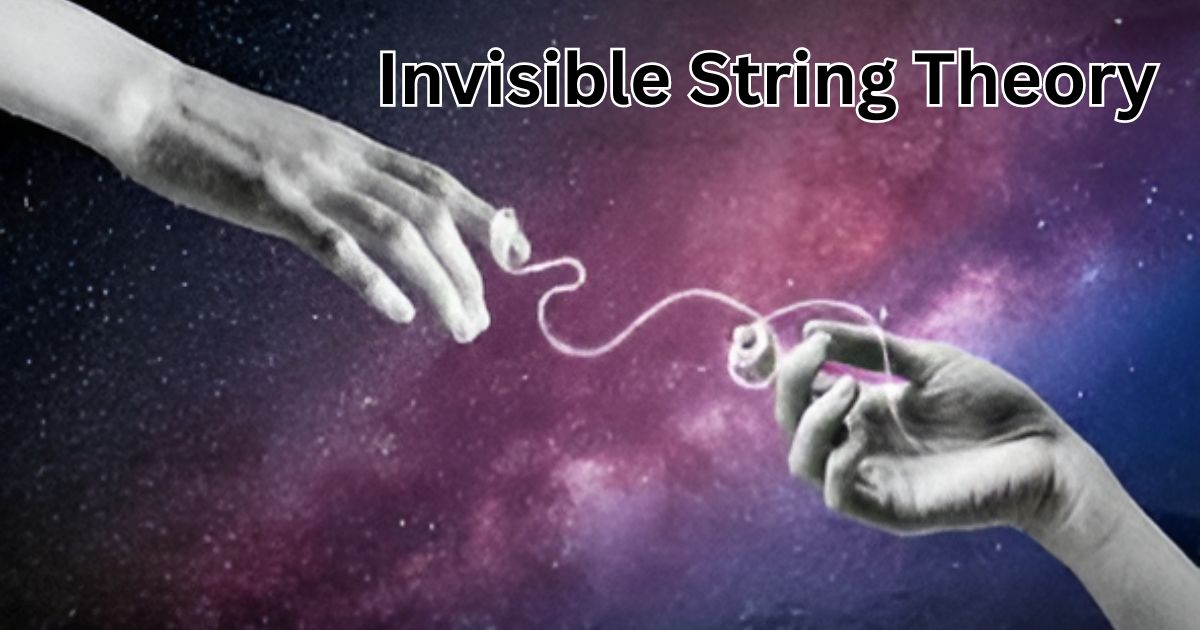Invisible String Theory, an extension of traditional string theory in theoretical physics, posits that the universe’s fundamental building blocks are one-dimensional “strings” that cannot be directly observed. This theory seeks to unify various forces of nature, including gravity and electromagnetism, under a single framework, offering insights into the universe’s underlying structure. It addresses profound questions in physics, such as the nature of dark matter and black holes, and has the potential to revolutionize technology, energy, and our understanding of space and time. This article explores the theory’s history, fundamental concepts, key discoveries, and ongoing challenges, providing a comprehensive overview of its significance in modern physics.
Historical Background
Origins of String Theory
String theory emerged in the late 20th century as a candidate for unifying the fundamental forces of nature. Initially developed to explain certain phenomena in particle physics, it proposed that the universe’s smallest constituents are not point-like particles but rather one-dimensional strings. These strings can vibrate at different frequencies, giving rise to the various particles observed in nature. Early proponents of string theory included Leonard Susskind, Yoichiro Nambu, and Holger Bech Nielsen, whose work laid the foundation for subsequent developments.
Evolution into Invisible String Theory
As string theory evolved, researchers began to explore the concept of invisible strings—those that exist beyond the reach of current observational techniques. This evolution was driven by the need to explain phenomena that could not be accounted for by visible strings alone, such as the existence of dark matter and the behavior of gravity at the quantum level. Invisible string theory extends traditional string theory by incorporating additional dimensions and forces, providing a more comprehensive framework for understanding the universe.
Key Contributors to Invisible String Theory
Key contributors to the development of invisible string theory include Edward Witten, who introduced the concept of M-theory, a unifying framework that encompasses all versions of string theory. Additionally, Lisa Randall and Raman Sundrum proposed models that incorporate extra dimensions, further advancing our understanding of invisible strings. These scientists and many others have made significant contributions to the field, pushing the boundaries of theoretical physics and expanding our knowledge of the cosmos.
Fundamental Concepts
What is Invisible String Theory?
Invisible string theory posits that the universe is composed of one-dimensional strings that are invisible to current observational tools. These strings vibrate at different frequencies, producing the particles and forces we observe. Unlike traditional string theory, which focuses on visible strings, invisible string theory explores the properties and implications of strings that exist beyond our observational capabilities. This theory aims to provide a unified description of all fundamental forces, including gravity, electromagnetism, and the strong and weak nuclear forces.
Basic Principles of Invisible String Theory
The basic principles of invisible string theory include the existence of multiple dimensions beyond the familiar three spatial dimensions and one-time dimension. These extra dimensions are compactified, meaning they are curled up at scales too small to be detected. Invisible strings can move and vibrate within these extra dimensions, influencing the behavior of particles and forces in ways that are not yet fully understood. The theory also predicts the existence of branes, multi-dimensional objects that strings can attach to, further complicating the universe’s structure.
Differences Between Visible and Invisible String Theories
The primary difference between visible and invisible string theories lies in the observational capabilities. Visible string theory deals with strings that can, in principle, be observed indirectly through their effects on particles and forces. Invisible string theory, on the other hand, focuses on strings that exist beyond the reach of current observational techniques, necessitating advanced theoretical and mathematical approaches to study them. Additionally, invisible string theory often involves more complex geometries and higher-dimensional spaces, making it a richer and more challenging field of study.
Theoretical Framework
Mathematical Foundations
The mathematical foundations of invisible string theory are deeply rooted in advanced concepts from quantum mechanics, general relativity, and higher-dimensional geometry. At its core, the theory uses complex equations to describe the behavior of strings and branes in multi-dimensional spaces. These equations are often formulated within the framework of superstring theory, which incorporates supersymmetry—a theoretical symmetry between bosons and fermions. The mathematics of invisible string theory is highly abstract and requires sophisticated tools from algebraic geometry, differential geometry, and topology.
The Role of Quantum Mechanics
Quantum mechanics plays a crucial role in invisible string theory, providing the principles that govern the behavior of strings at the smallest scales. Invisible string theory extends the probabilistic nature of quantum mechanics to higher dimensions and more complex interactions. Quantum fluctuations and uncertainties are integral to the theory, influencing the vibrations and interactions of invisible strings. This quantum perspective allows for a more comprehensive understanding of the fundamental particles and forces that make up the universe.
Integration with General Relativity
Integrating invisible string theory with general relativity is one of the most significant challenges and achievements in theoretical physics. General relativity, which describes the behavior of gravity at large scales, must be reconciled with the quantum nature of invisible strings. This integration involves modifying Einstein’s equations to incorporate the effects of extra dimensions and invisible strings. The resulting framework, often referred to as quantum gravity, aims to provide a unified description of all fundamental forces, including gravity, at both large and small scales.
Key Components
Strings and Branes
Strings and branes are fundamental components of invisible string theory. Strings are one-dimensional objects that can vibrate at different frequencies, giving rise to various particles and forces. Branes, on the other hand, are multi-dimensional objects to which strings can attach. These branes can have different dimensionalities, ranging from zero-dimensional points to higher-dimensional surfaces. The interactions between strings and branes are central to understanding the dynamics of invisible string theory and its implications for the universe’s structure.
The Concept of Extra Dimensions
Extra dimensions are a cornerstone of invisible string theory. While we experience the universe in three spatial dimensions and one-time dimension, invisible string theory posits the existence of additional compactified dimensions. These dimensions are curled up at incredibly small scales, making them undetectable by current observational tools. Strings can move and vibrate within these extra dimensions, influencing the properties and behavior of particles and forces. The concept of extra dimensions allows for a richer and more complex understanding of the universe’s fundamental structure.
Invisible Strings: Definition and Properties
Invisible strings are theoretical entities that exist beyond the reach of current observational techniques. They are one-dimensional objects that vibrate at different frequencies, producing the various particles and forces observed in nature. Unlike visible strings, which can be indirectly detected through their effects, invisible strings interact in higher-dimensional spaces and remain elusive. Their properties and behavior are governed by advanced mathematical equations and principles from quantum mechanics and general relativity. Studying invisible strings requires innovative theoretical approaches and a deep understanding of the universe’s underlying structure.
Major Discoveries
Significant Breakthroughs in Invisible String Theory
Significant breakthroughs in invisible string theory have advanced our understanding of the universe’s fundamental structure. One such breakthrough is the discovery of dualities, which reveal deep connections between different string theories and suggest a unified framework. Another major advancement is the development of M-theory, proposed by Edward Witten, which unifies all five consistent superstring theories into a single, eleven-dimensional framework. These breakthroughs have provided new insights into the nature of space, time, and fundamental particles, pushing the boundaries of theoretical physics.
Impact on Modern Physics
The impact of invisible string theory on modern physics is profound. It offers potential solutions to long-standing problems, such as the unification of gravity with the other fundamental forces and the nature of dark matter. Invisible string theory also provides a framework for understanding black holes and their behavior at the quantum level. These contributions have influenced various fields, from cosmology to particle physics, and have inspired new experimental and observational approaches to test the theory’s predictions.
Contributions to Cosmology
Invisible string theory has made significant contributions to cosmology, the study of the universe’s origin, structure, and evolution. It offers potential explanations for the Big Bang and the subsequent expansion of the universe. The theory’s incorporation of extra dimensions and higher-dimensional objects provides new insights into the nature of cosmic inflation and the distribution of matter and energy in the universe. Additionally, invisible string theory suggests mechanisms for the formation of cosmic structures, such as galaxies and clusters, and sheds light on the behavior of dark matter and dark energy.
Applications
Invisible String Theory in Particle Physics
In particle physics, invisible string theory offers a framework for understanding the fundamental particles and forces that constitute matter. It provides a unified description of the strong, weak, and electromagnetic forces, as well as gravity, within a single theoretical framework. Invisible string theory also predicts the existence of new particles, such as supersymmetric partners to known particles, which could be detected in high-energy experiments. These predictions guide the search for new physics beyond the Standard Model, driving advancements in particle accelerators and experimental techniques.
Implications for Black Hole Studies
Invisible string theory has profound implications for the study of black holes. It offers a framework for understanding the quantum behavior of black holes, including their entropy and information content. The theory’s incorporation of extra dimensions and higher-dimensional objects provides new insights into the nature of black holes and their interactions with surrounding matter and energy. Invisible string theory also suggests potential mechanisms for black hole formation, growth, and evaporation, contributing to our understanding of these enigmatic cosmic objects.
Potential Technological Advances
The insights gained from invisible string theory have the potential to drive technological advancements. Understanding the fundamental principles of invisible strings could lead to new technologies for manipulating matter and energy at the quantum level. Additionally, the theory’s predictions of new particles and forces could inspire innovations in materials science, energy generation, and information technology. While these applications are speculative, the theoretical advancements in invisible string theory provide a rich foundation for future technological breakthroughs.
Experimental Evidence
Methods of Detecting Invisible Strings
Detecting invisible strings presents significant challenges, given their nature and the limitations of current observational tools. However, several methods are being explored to infer their existence indirectly. One approach involves studying the effects of invisible strings on high-energy particle collisions in particle accelerators, such as the Large Hadron Collider (LHC). Another method involves observing cosmic phenomena, such as the behavior of dark matter and gravitational waves, which may provide indirect evidence of invisible strings. Advanced mathematical and computational techniques are also employed to predict and analyze the signatures of invisible strings.
Current Experiments and Observations
Several experiments and observations are underway to test the predictions of invisible string theory. High-energy particle collisions at the LHC and other particle accelerators are being analyzed for evidence of supersymmetric particles and other signatures predicted by the theory. Observations of cosmic phenomena, such as gravitational waves and the distribution of dark matter, are also being used to test the theory’s predictions. These efforts involve collaboration between experimentalists and theorists, combining advanced observational techniques with sophisticated theoretical models.
Challenges in Proving Invisible String Theory
Proving invisible string theory presents significant challenges due to the limitations of current observational and experimental techniques. The theory’s predictions often involve phenomena at energy scales and spatial dimensions beyond the reach of existing tools. Additionally, the abstract and complex nature of the theory requires advanced mathematical and computational approaches to test its predictions. Despite these challenges, ongoing research and technological advancements are gradually providing new insights and potential avenues for testing invisible string theory.
Also Read: Liam Costner
Theoretical Challenges
Unresolved Issues in Invisible String Theory
Several unresolved issues remain in invisible string theory, reflecting the complexity and breadth of the field. One significant challenge is the lack of a complete and consistent formulation of the theory, particularly in higher dimensions. Additionally, the theory’s predictions often involve energy scales and spatial dimensions beyond current observational capabilities, making it difficult to test its predictions directly. Theoretical issues, such as the nature of supersymmetry and the role of extra dimensions, also remain unresolved, requiring further research and refinement.
Criticisms and Controversies
Invisible string theory has faced criticisms and controversies within the scientific community. Some critics argue that the theory’s predictions are too speculative and lack direct experimental evidence. Others question the theory’s reliance on extra dimensions and complex mathematical frameworks, suggesting that simpler explanations may be possible. Despite these criticisms, invisible string theory remains a vibrant and active area of research, driven by its potential to address fundamental questions in physics and cosmology.
Alternative Theories and Their Comparison
Several alternative theories have been proposed as potential explanations for the phenomena addressed by invisible string theory. These include loop quantum gravity, which attempts to quantize spacetime directly, and other approaches that seek to unify the fundamental forces without relying on extra dimensions. Comparing these theories involves evaluating their predictive power, mathematical consistency, and compatibility with experimental observations. While invisible string theory remains a leading candidate, ongoing research and experimentation are necessary to determine its viability relative to alternative approaches.
Future Directions
Ongoing Research and Developments
Ongoing research and developments in invisible string theory continue to push the boundaries of theoretical physics. Scientists are exploring new mathematical frameworks, advanced computational techniques, and innovative experimental approaches to test the theory’s predictions. Collaborative efforts between theorists and experimentalists are driving advancements in particle physics, cosmology, and quantum gravity, providing new insights into the nature of the universe. These ongoing efforts aim to refine and expand the theoretical framework of invisible string theory, addressing unresolved issues and exploring new frontiers.
Predictions for Future Discoveries
Invisible string theory makes several predictions for future discoveries, which could significantly impact our understanding of the universe. These predictions include the detection of supersymmetric particles, evidence of extra dimensions, and new insights into the nature of dark matter and dark energy. Additionally, the theory suggests potential mechanisms for cosmic inflation, black hole behavior, and the unification of fundamental forces. Future discoveries in these areas could provide critical evidence supporting invisible string theory and drive new advancements in theoretical and experimental physics.
The Next Steps in Invisible String Theory
The next steps in invisible string theory involve addressing unresolved issues, refining theoretical models, and developing new experimental approaches. This includes exploring new mathematical and computational techniques, advancing particle accelerator experiments, and analyzing cosmic observations. Collaborative efforts between physicists, mathematicians, and engineers are essential for driving these advancements and testing the theory’s predictions. The ultimate goal is to achieve a comprehensive and consistent framework that unifies all fundamental forces and provides a deeper understanding of the universe’s structure.
Notable Scientists
Pioneers of Invisible String Theory
The pioneers of invisible string theory include several influential scientists who have made significant contributions to the field. Edward Witten is one of the most prominent figures, known for his work on M-theory and his contributions to superstring theory. Other notable pioneers include Leonard Susskind, Yoichiro Nambu, and Holger Bech Nielsen, whose early work laid the foundation for the development of string theory and its evolution into invisible string theory. These pioneers have advanced our understanding of the universe’s fundamental structure and inspired new generations of physicists.
Contemporary Researchers
Contemporary researchers in invisible string theory continue to build on the foundations laid by the pioneers, exploring new theoretical and experimental approaches. Notable contemporary researchers include Lisa Randall and Raman Sundrum, who proposed models incorporating extra dimensions, and Juan Maldacena, known for his work on the AdS/CFT correspondence. These researchers, along with many others, are pushing the boundaries of theoretical physics, exploring new frontiers in string theory, quantum gravity, and cosmology.
Influential Publications
Influential publications in invisible string theory have shaped the field and advanced our understanding of the universe’s fundamental structure. Key papers include Edward Witten’s work on M-theory, Lisa Randall and Raman Sundrum’s models of extra dimensions, and Juan Maldacena’s AdS/CFT correspondence. These publications have provided new insights, mathematical frameworks, and experimental predictions, driving advancements in theoretical and experimental physics. They serve as foundational texts for researchers and students in the field, guiding ongoing research and exploration.
Public Perception
Invisible String Theory in Popular Culture
Invisible string theory has captured the public’s imagination, appearing in popular culture through books, movies, and television shows. It has been featured in science fiction stories, where its concepts of extra dimensions and hidden forces provide rich material for creative exploration. Popular science books, such as Brian Greene’s “The Elegant Universe,” have introduced the theory to a broader audience, explaining its principles in an accessible and engaging manner. These cultural representations have helped raise awareness and interest in invisible string theory and its implications for our understanding of the universe.
Common Misconceptions
Despite its popularity, invisible string theory is often misunderstood by the general public. Common misconceptions include the belief that it is purely speculative with no experimental basis or that it can explain all phenomena in the universe without further research. Additionally, the theory’s reliance on complex mathematics and extra dimensions can be challenging to grasp, leading to oversimplified or incorrect interpretations. Addressing these misconceptions requires effective science communication, emphasizing the theory’s current status, ongoing research, and the importance of experimental validation.
Educational Outreach and Resources
Educational outreach and resources play a crucial role in improving public understanding of invisible string theory. Universities, research institutions, and science museums offer lectures, workshops, and interactive exhibits to explain the theory’s principles and implications. Online resources, including videos, articles, and educational websites, provide accessible and engaging content for learners of all ages. These efforts aim to demystify invisible string theory, making it more understandable and inspiring future generations of scientists and enthusiasts.
Interdisciplinary Connections
Invisible String Theory and Astrophysics
Invisible string theory has significant connections with astrophysics, particularly in understanding the universe’s large-scale structure and behavior. The theory provides insights into the nature of dark matter, dark energy, and cosmic inflation, offering potential explanations for these phenomena. Additionally, invisible string theory’s predictions about the behavior of black holes and the early universe have implications for astrophysical observations and experiments. These interdisciplinary connections drive collaborative research, combining theoretical models with observational data to explore the universe’s fundamental nature.
Relations with Quantum Computing
The principles of invisible string theory have potential applications in quantum computing, a field focused on developing new computational technologies based on quantum mechanics. The theory’s mathematical frameworks and concepts of higher-dimensional spaces could inspire new algorithms and computational approaches. Additionally, the study of quantum entanglement and information in invisible string theory may provide insights into the behavior of quantum systems and the development of more efficient quantum computers. These connections highlight the potential for theoretical physics to drive advancements in cutting-edge technologies.
Influence on Material Science
Invisible string theory’s concepts of fundamental particles and forces can influence material science, the study of the properties and behavior of materials. Understanding the interactions of invisible strings and their effects on matter could inspire the development of new materials with unique properties, such as superconductors or metamaterials. Additionally, the theory’s mathematical frameworks and computational techniques may provide new tools for modeling and analyzing complex material systems. These interdisciplinary connections demonstrate the potential for invisible string theory to impact various fields and drive technological advancements.
Philosophical Implications
The Nature of Reality and Invisible String Theory
Invisible string theory raises profound philosophical questions about the nature of reality. By positing the existence of invisible dimensions and fundamental strings, the theory challenges our conventional understanding of space, time, and matter. It suggests that the universe’s underlying structure is far more complex and nuanced than previously thought, with hidden layers and interactions that defy intuitive comprehension. These philosophical implications invite us to reconsider our perceptions of reality and the limits of human knowledge.
Ethical Considerations in Research
The pursuit of invisible string theory and related scientific endeavors also raises ethical considerations. The allocation of resources, the potential risks of high-energy experiments, and the broader societal implications of technological advancements inspired by the theory all require careful consideration. Ethical research practices, transparency, and public engagement are essential to ensure that scientific progress aligns with societal values and benefits humanity as a whole. These considerations highlight the importance of responsible and reflective scientific practice.
Invisible String Theory and Human Understanding
Invisible string theory represents a significant advancement in our quest to understand the universe’s fundamental nature. It extends the boundaries of human knowledge, offering new insights into the fabric of reality and the forces that govern it. The theory’s development reflects humanity’s enduring curiosity and drive to explore the unknown, pushing the limits of what we can perceive and comprehend. By expanding our understanding of the universe, invisible string theory contributes to our collective intellectual and cultural heritage, inspiring future generations to continue the pursuit of knowledge.
Conclusion
Invisible string theory represents a bold and innovative attempt to explain the universe’s fundamental nature. By positing the existence of invisible strings and extra dimensions, the theory provides a framework for unifying the fundamental forces of nature and addressing unresolved questions in physics and cosmology. Key points discussed in this article include the history and development of the theory, its mathematical foundations, potential technological and experimental advancements, and the philosophical and interdisciplinary implications of its concepts.









